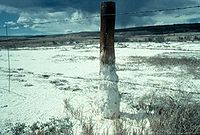
Photo from wikipedia
ABSTRACT Using leaching to remove salt beyond the root zone by deep percolation requires more water to be added and this increases the stress on water resources. We hypothesized that… Click to show full abstract
ABSTRACT Using leaching to remove salt beyond the root zone by deep percolation requires more water to be added and this increases the stress on water resources. We hypothesized that biochar addition could mitigate salt stresses on plants and reduce the leaching fraction. For this purpose, seven irrigation water salinity levels with electrical conductivities of 1, 2, 4, 5, 6, and 7.0 dS m-1 and tap water (0.75 dS m−1) as a control treatment coupled with three biochar applications at rates of 0% (B0), 5% (B1), and 10% (B2) were used in a randomized design with three replications. Irrigation practices were realized by considering the weight of each pot. The results revealed that the actual evapotranspiration (AET) values ranged from 30.56 to 13.83 L pot−1 for the S0B2 and B0S6 treatments. Also, the results revealed that the total water applied (TWA) for salt leaching decreased following the applications of biochar and increased with increase of electrical conductivity. The analysis of variance showed significant differences among actual yield (AY), leaching yield (LY), and simulated yield (SY) under biochar addition and irrigation treatments. For B0, the greatest fruit yield (219.4 g pot−1) was obtained from the S0 under LY. Similar results were obtained for B1 and B2 under S0 in LY with maximum fruit yield of 250.7 and 277.7 g plant−1, respectively. Realized leaching fractions under non-biochar ranged from 5% to 78% whereas for B1 they ranged from 4% to 58%, while for B2 they ranged from 3% to 32%. Results of the water-use efficiency (WUE) showed that the lowest WUE0 and WUE1 (0.00 and 5.53 g L−1) were obtained under B0S6 whereas the highest values (7.93 and 11.1 g L−1) were observed under B2S0. Moreover, we found that biochar mitigated salinity stress in Okra by capturing transient sodium ions and reducing ion toxicity, which are preferentially absorbed onto the biochar surfaces, while releasing potassium, calcium, and magnesium ions from biochar into the soil solution.
Journal Title: Communications in Soil Science and Plant Analysis
Year Published: 2018
Link to full text (if available)
Share on Social Media: Sign Up to like & get
recommendations!